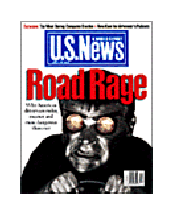Michael Fumento
Factual · Powerful · Original · Iconoclastic
'Road Rage' Epidemic Merely Media Mayhem
January 01, 1998 · Michael Fumento · Road rage
"Road Warriors: Aggressive Drivers Turn Freeways into Free-for-alls," claimed a headline in the Chicago Tribune last year.
"Armed with everything from firearms to Perrier bottles to pepper spray and eggs," the text began, "America’s drivers are taking frustrations out on each other in startling numbers." Newsweek warned, "Road Rage: We’re Driven to Destruction."
Last January, Time declared, "It’s high noon on the country’s streets and highways. This is road recklessness, auto anarchy, an epidemic of wanton carmanship." The cover of the August 16 issue of USA Weekend blared: "Putting the Brakes on Road Rage."
But headlines notwithstanding, there was not — there is not — the least statistical or other scientific evidence of more-aggressive driving on our nation’s roads. Indeed, accident, fatality, and injury rates have been edging down. This "epidemic" is nothing but a media invention, inspired primarily by something as simple as a catchy alliteration: ROAD RAGE.
The term, and the alleged epidemic, was quickly popularized by lobbying groups, politicians, opportunistic therapists, cash-seeking police departments, and even the National Highway Traffic and Safety Administration (NHTSA).
The only statistical evidence anybody even bothers to proffer for increased aggressive driving was commissioned by the American Automobile Association from a fellow named Louis Mizell, who specializes in writing books that scare the hell out of people, such as Target U.S.A. and Street Sense for Parents: Keeping Your Child Safe in a Violent World.
Mizell gave AAA what they wanted, providing a report that aggressive driving had increased by about 60 percent from 1990 to 1996. But his "database" comprised a pitifully small number of newspapers, police departments, and insurance company records that can be read in any number of ways.
How small? Consider that during those six years, he found 218 deaths directly attributable to road rage during a time when 290,000 Americans died from vehicular accidents. Even in the hands of professional surveyors, this would be a worthlessly tiny sample. But Mizell didn’t even factor in statistical significance. In short, his "study" was worthless; yet it’s the best the road rager racket has to offer for such statements as a former congressional aide who declared, "It’s a national disaster . . . It’s making our roads some of the most dangerous places in the country."
Really? "Road rage" was first coined in 1988. In the first few years after that media used it no more than three times a year. But by last year it was used over 4,000 times; this year the trend indicates it will be about 7,000 times. During the period 1987 to 1997, however, deaths per million vehicle miles driven dropped by almost a third. Passenger car crashes fell by 40 percent. For both categories, these are the lowest they have been since the government began keeping records.
But government safetycrats refuse to recognize this. NHTSA head Ricardo Martinez last year testified before Wisconsin Republican Tom Petri’s House Subcommittee on Surface Transportation that highway deaths were INCREASING and claimed, "one third of [overall] crashes and about two thirds of the resulting fatalities can be attributed to behavior associated with aggressive driving."
The inevitable headlines included: "Temper Cited as Cause of 28,000 Road Deaths a Year" (The New York Times), and "Seething Motorists Make Cars Weapons" (the Albany Times Union).
But Liz Neblett, a spokeswoman for the NHTSA, the source for the two-thirds figure, candidly told me, "We don’t have hard numbers, but aggressive driving is almost everything. It includes weaving in and out of traffic, driving too closely, flashing your lights — all kinds of stuff. Drinking, speeding, almost everything you can think of, can be boiled down to aggressive driving behaviors." Martinez could conceivably label virtually every accident the result of aggressive driving.
Our roads become safer by the year; it’s reading the newspaper that’s becoming more hazardous. Originally "road rage" meant one driver acting against another. No longer. By last year it had come to include a Washington, D.C., bicyclist who shot the driver of a car who ran into him, and a Scottish couple who threatened a driver with a knife after his BMW pancaked their pooch.
The definition of "road rage" now requires neither a road nor rage. One newspaper published a story about developing pristine land under the headline "Road Rage Has Taken Toll on Wilderness," and USA Today discussed people angry about their insurance premiums under the headline "Drivers Feel ’Road Rage’ Over High Insurance Rates."
Like any other fabricated epidemic, the more you tell people it’s there, the more they see it. Tailgating using to be called tailgating. Now we consider it road rage. The New York Daily News assures us that using a car phone is road rage. "Hi honey, I love you. Be home soon," is hence equated with bowling over bicyclists with your Buick.
Road rage has become a tremendous growth industry, and let’s face it; John Q. Public does get entertainment value out of it.
But the problem with this faux epidemic is the distraction from real road problems. In recent years Americans have waged a fairly successful campaign against drunken driving. Deaths related to drunken driving have plummeted.
But a poll in March of last year, commissioned by AAA Potomac, showed that 48 percent of those surveyed identified "aggressive drivers" as their chief concern, whereas only 28 percent so identified drunk drivers. What happens to the drunken-driving campaigns now that road rage has become our greatest fear?
